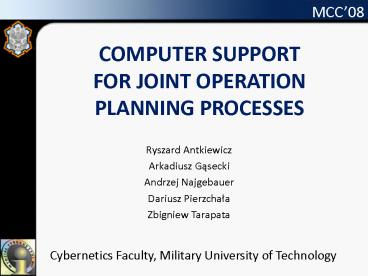COMPUTER SUPPORT FOR JOINT OPERATION PLANNING PROCESSES - PowerPoint PPT Presentation
1 / 19
Title:
COMPUTER SUPPORT FOR JOINT OPERATION PLANNING PROCESSES
Description:
Define the endstate (in terms of desired strategic political-military outcomes). Define the objectives that describe the ... G Berge's graph without loops, ... – PowerPoint PPT presentation
Number of Views:88
Avg rating:3.0/5.0
Title: COMPUTER SUPPORT FOR JOINT OPERATION PLANNING PROCESSES
1
COMPUTER SUPPORT FOR JOINT OPERATION PLANNING
PROCESSES
MCC08
- Ryszard Antkiewicz
- Arkadiusz Gasecki
- Andrzej Najgebauer
- Dariusz Pierzchala
- Zbigniew Tarapata
Cybernetics Faculty, Military University of
Technology
2
Joint operation planning
MCC08
- The process of joint operation design is outlined
in the following steps 3 - Define the endstate (in terms of desired
strategic political-military outcomes). - Define the objectives that describe the
conditions necessary to meet the endstate. - Define the desired effects that support the
defined objectives. - Identify friendly and enemy center(s) of gravity
(COG) using a systems approach. - Identify decisive points that allow the joint
force to affect the enemys COG and look for
decisive points necessary to protect friendly
COGs. - Identify lines of operation that describe how
decisive points are to be achieved and linked
together in such a way as to overwhelm or disrupt
the enemys COG. - Identify how decisive points relate to phases to
identify how operations are arranged in time,
space, and effect, and to identify changes in
phases, especially the critical transition from
Phase III (Dominate) to Phase IV (Stabilize). - Complete the detailed synchronization and
integration of forces and functions, tasks,
targets, and effects centered on decisive points
and
3
Campaign planning concept (course of action COA)
MCC08
4
Mathematical model of joint operation
MCC08
,
- COA can be defined as the following network
- where
- G Berges graph without loops,
- D set of graph vertices, vertices are related
to decisive points of COA, - U - set of edges of graph, edges define sequence
of decisive point achieving, - - family of functions defined at graph
vertices,
5
Mathematical model of joint operation (2)
MCC08
,
.
- family of functions defined at
graph edges Values of the following functions
are determined by planners during planning
process the shortest time of
completion of tasks, which allow to achieve
decisive point d, the longest time
of completion of tasks, which allow to achieve
decisive point d, the most probable
time of completion of tasks, which allow to
achieve decisive point d,
6
Mathematical model of joint operation (3)
MCC08
,
.
baseline probability of completion tasks,
which allow to achieve decisive point d,
value of this function reflects negative
influence of achieving decisive point d on
probability of achieving decisive point k,
value of this function reflects positive
influence of achieving decisive point d on
probability of achieving decisive point k.
7
Mathematical model of joint operation (4)
MCC08
,
.
Applying presented model, we will further show
method of evaluation of three important
quantitative characteristics of joint operation
- probability of completion of tasks which
allow to achieve decisive point d in time
shorter than t, completion of above tasks does
not guarantee achieving of decisive point, -
probability of achieving decisive point d in
unlimited time, - probability of achieving
decisive point d in time shorter than t.
8
Distribution of time of joint operation execution
MCC08
- We assume, that
- 1. xk n
- 2. G(Ydt) F(d,t)
- 3. X1 0, Y1 A1,
- 4. Yi Xi Ai, i 2,3,,n
- 5. Yn Project Completion Time.
- Where
- Xi Start Time of Activity i, taking on all
values in the range - Ai Activity Time of Activity i, taking on all
values in the range - Yi Finish Time of Activity i, taking on all
values in the range - Values are related to the functions
from our model on the
following way
9
MCC08
- The distribution functions for the random
variables Xi, Yi are calculated as follows - Where
- If we assume, that Xi and Ai are independent, we
will have
10
Conditioning Set
MCC08
Number of Nodes n Number of C-Nodes m Number of
O-nodes n-m
Theorem. Any node i is a C-Node (Conditioning
Node) if 1. Node i has two or more immediate
successors, or 2. Any successor of node i is a
C-Node.
11
Comparison
MCC08
12
The idea of evaluation
MCC08
- If Pred(k)d, then it is assumed that
- if decisive point d is achieved than
- if decisive point d is not achieved than
13
The idea of evaluation
MCC08
- If Pred(k)gt1, we define additional quantities
14
The idea of evaluation
MCC08
- Unconditional probability of decisive point k
achievement is computed via the expression - Applying formulas for and , we could compute
probability of achieving decisive point d in time
shorter than via the expression
15
Computer implementation
MCC08
The editor's implementation was conducted with
recommendations basing on object-oriented
methodologies. The main programming language is
Java.
Logical software layer
16
MCC08
Example of joint operations input data
17
Example of joint operations - graphical model
with results
MCC08
18
MCC08
Example of joint operations numerical results
Results for DP5 Minimal finish time 3.0 Maximal
finish time 6.0
Results for DP3 Minimal finish time
6.0 Maximal finish time 11.0
19
Conclusions
MCC08
- Using presented computer package we could
calculate important quantitative characteristics
of joint operations. - This package could be a part of command and
control systems - The model presented in the paper could be applied
not only for military joint operation, but for
all complex operation, where execution of many
different and mutually dependent tasks leads us
to a goal. - Methods of function value computation
could be in a relatively simple way modified in
order to take into account continuous probability
distribution of single task execution time.

